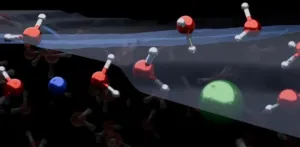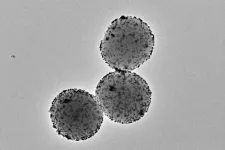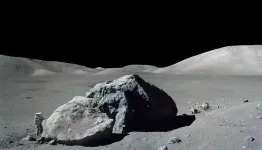(Press-News.org) Two teams from UNIL and EPFL have succeeded in demonstrating that the insect synthesizes nutrients for native gut microbes. A study published in « Nature Microbiology ».
Bacteria have adapted to all terrestrial environments. Some have evolved to survive in the gut of animals, where they play an important role for their host; they provide energy by degrading indigestible food, they train and regulate the immune system, they protect against invasion by pathogenic bacteria, and they synthesize neuroactive molecules that regulate the behavior and cognition of their host.
These are great advantages for the host, but what advantages do the bacteria derive? Certainly, the host provides a comfortable home, but does the host also provide nutrients to native bacteria that enable them to colonize?
It is a difficult question that is possible to answer with the aide of … bees. Professor Philipp Engel in UNIL's Department of Fundamental Microbiology (DMF) in Dorigny has set his sights on the western honey bee (Apis mellifera). They are a relatively simple system to study compared to humans and their gut microbiota. Best known for the delicious honey they produce, this insect is also an excellent experimental model for gut microbiota research: it has acquired a remarkably simple and stable microbiota, composed of only around twenty bacterial species. In the laboratory of the Engel group, bees are raised without gut bacteria, and then fed specific species that will colonize the gut.
Full board for the bacteria
Bees love to gorge on nutrient rich pollen and honey, but they can also survive for long periods on a diet of only sugar water. But what happens to the gut bacteria? A study published on January 15, 2024 in Nature Microbiology by the Lausanne scientists reveals new insights: Dr. Andrew Quinn and PhD candidate Yassine El Chazli began by looking for evidence that the bacteria share nutrients with one another when bees receive nothing more than sugar water. Remember that intestinal bacteria are known to consume dietary nutrients as well as waste products from other microorganisms.
However, their first results left them perplexed: One specific bacterium in the gut, Snodgrassella alvi, cannot metabolize sugar to grow, and yet it still colonized the bee gut when sugar was the only food in the diet and no other bacteria were present.
By measuring metabolites in the gut, the scientists discovered that the bee synthesizes multiple acids (citric acid, malic acid, 3-hydroxy-3-methylglutaric acid, etc.) that are exported into the gut and were less abundant when S. alvi was present. These results led them to pose an unexpected hypothesis: Does the bee directly enable S. alvi to colonize its gut by furnishing the necessary nutrients?
Picture proof
Proving this hypothesis was surprisingly difficult, but fortunately, the key expertise was just across the road in the laboratory of Professor Anders Meibom (affiliated with UNIL and EPFL). Professor Meibom and his team are experts in measuring the flux of metabolites in complex environments at nanometers scale resolution by using one of the few NanoSIMS (Nanoscale Secondary Ion Mass Spectrometry) instruments in Europe.
Together the two teams devised an experiment in which microbiota free bees received a special diet of glucose where the natural 12C atoms of carbon in the glucose were replaced with the naturally rare 13C “labelled” isotopes. The bees were then colonized with S. alvi. At the end of the experiment, the fixed guts embarked on a journey, first passing by the electron microscopy facility of UNIL, led by Senior Lecturer Christel Genoud. Then, they moved on to the laboratory of professor Meibom and his NanoSIMS. In the end, the scientists were able to construct a 2-dimensional “image” of the 13C atoms in the gut of the bee, which showed that the S. alvi cells were significantly enriched in 13C, which reflected the 13C enrichment of the acids present in the gut.
To the rescue of the bees
Thus, in a single image, the team was able to show conclusively that the bee synthesizes food for its intestinal bacteria. “This is a wonderful example of cutting-edge, truly interdisciplinary scientific collaboration, which has brought together several scientific units within UNIL and EPFL," comments Anders Meibom. When we work together in this way, there are not many academic environments in the world that have more to offer," adds the professor, who is a pioneer in the application of NanoSIMS technologies to the intransigent questions of biology.
"It's possible that many other gut microorganisms also feed on host-derived compounds," says co-lead author Dr. Andrew Quinn, imagining an extension of this approach to other bacteria. Refocusing on bees: "These results could also explain why bees have such a specialized and conserved gut microbiota." And these mechanisms could play a role in bees' vulnerability to climate change, pesticides, or new pathogens: "Their vulnerability could result from a disruption in this intricate metabolic synergy between the bee and its gut microbiota. We already know that exposure to the herbicide glyphosate makes bees more susceptible to pathogens and reduces the abundance of S. alvi in the gut. Now, armed with these new findings, we're looking for answers to these pressing questions."
END
When bees nourish their microbiota
2024-01-15
ELSE PRESS RELEASES FROM THIS DATE:
Accelerating how new drugs are made with machine learning
2024-01-15
Researchers have developed a platform that combines automated experiments with AI to predict how chemicals will react with one another, which could accelerate the design process for new drugs.
Predicting how molecules will react is vital for the discovery and manufacture of new pharmaceuticals, but historically this has been a trial-and-error process, and the reactions often fail. To predict how molecules will react, chemists usually simulate electrons and atoms in simplified models, a process which is computationally expensive and often inaccurate.
Now, researchers from the University of Cambridge ...
Water molecule discovery contradicts textbook models
2024-01-15
Textbook models will need to be re-drawn after a team of researchers found that water molecules at the surface of salt water are organised differently than previously thought.
Many important reactions related to climate and environmental processes take place where water molecules interface with air. For example, the evaporation of ocean water plays an important role in atmospheric chemistry and climate science. Understanding these reactions is crucial to efforts to mitigate the human effect on our planet.
The distribution of ions at the interface of air and water can affect atmospheric processes. However, a precise understanding of ...
U.S. air pollution rates on the decline but pockets of inequities remain
2024-01-15
Over the last decades, air pollution emissions have decreased substantially; however, the magnitude of the change varies by demographics, according to a new study by Columbia University Mailman School of Public Health. The results indicate there are racial/ethnic and socioeconomic disparities in air pollution emissions reductions, particularly in the industry and energy generation sectors. The findings are published in the journal Nature Communications.
The research provides a national investigation of air pollution emission changes in the 40 years following the enactment of the Clean Air ...
New Scientific Reports publication reveals major difference in genomes of American and Chinese chestnut
2024-01-15
The chromosomes of American and Chinese chestnut are not so similar after all, at least in one key region of the genome – the nucleolus organizing region (NOR).
The finding, published in a forthcoming article in Scientific Reports, has major implications for anyone with the goal of conferring blight-resistance to American chestnuts through hybridization with the Chinese chestnut.
“This is an unprecedented finding in the field of plant cytology,” says Nurul Faridi, a Forest Service geneticist and lead author of the study.
Traditional ...
Solid-state qubits: Forget about being clean, embrace mess
2024-01-15
New findings debunk previous wisdom that solid-state qubits need to be super dilute in an ultra-clean material to achieve long lifetimes. Instead, cram lots of rare-earth ions into a crystal and some will form pairs that act as highly coherent qubits, shows paper in Nature Physics.
Clean lines and minimalism, or vintage shabby chic? It turns out that the same trends that occupy the world of interior design are important when it comes to designing the building blocks of quantum computers.
How to make qubits that retain their quantum information long enough to be useful is one of the major barriers to practical quantum computing. It’s widely accepted that the ...
Bladder tumors reduced by 90% using nanorobots
2024-01-15
Bladder cancer has one of the highest incidence rates in the world and ranks as the fourth most common tumour in men. Despite its relatively low mortality rate, nearly half of bladder tumours resurface within 5 years, requiring ongoing patient monitoring. Frequent hospital visits and the need for repeat treatments contribute to making this type of cancer one of the most expensive to cure.
While current treatments involving direct drug administration into the bladder show good survival rates, their therapeutic efficacy remains low. A promising alternative involves the use of nanoparticles capable of delivering therapeutic agents directly to the tumour. ...
Research sheds new light on Moon rock formation solving major puzzle in lunar geology
2024-01-15
New research has cracked a vital process in the creation of a unique rock type from the Moon. The discovery explains its signature composition and very presence on the lunar surface at all, unravelling a mystery which has long eluded scientists.
The study, published today in Nature Geoscience, reveals a key step in the genesis of these distinctive magmas. A combination of high temperature laboratory experiments using molten rocks, together with sophisticated isotopic analyses of lunar samples, identify a critical reaction that controls their composition.
This reaction took place in the deep lunar interior some three and a half ...
Priming, shaping and polishing: In search of a HIV vaccine
2024-01-15
Worldwide, an estimated, 40 million people live with HIV. Two-thirds of this group on the African continent. In 2022, more than 600,000 people died from HIV-related causes and more than 1.3 million were infected. There is no vaccine against the world's second most deadly infection, after TB. Thanks to a grant from the Bill & Melinda Gates Foundation, Amsterdam UMC's Rogier Sanders leads a project that aims to develop the first effective HIV vaccine.
"We hope to be able ...
Vigilant monitoring is needed to manage cardiac risks in patients using antipsychotics, doctors say
2024-01-15
Philadelphia, January 15, 2024 – The use of the antipsychotic drugs quetiapine and haloperidol is associated with an increased risk of ventricular arrhythmias and sudden cardiac death (SCD) caused by drug-induced QT prolongation, reports a new study in Heart Rhythm, the official journal of the Heart Rhythm Society, the Cardiac Electrophysiology Society, and the Pediatric & Congenital Electrophysiology Society, published by Elsevier. Caution is advised to manage cardiac risks in patients prescribed ...
Singapore study reveals impact of early life adversity on a child’s brain development
2024-01-15
Leveraging neuroimaging data from the Growing Up in Singapore Towards healthy Outcomes (GUSTO) cohort, researchers from A*STAR’s Singapore Institute for Clinical Sciences (SICS) identified an association between early life adversity and the pace of brain development in childhood.
SINGAPORE – A study led by researchers from A*STAR's Singapore Institute for Clinical Sciences (SICS) has found evidence suggesting that children exposed to elevatec levels of early life adversity (ELA) exhibit an accelerated pattern of brain development during the preschool years. When exposed to ELA, such as a mother's mental and ...




